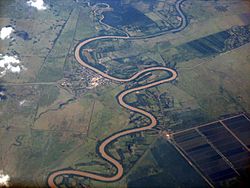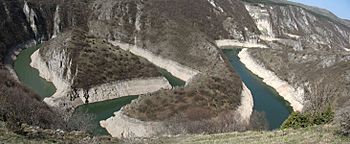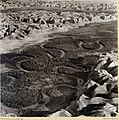Meander facts for kids


A meander is a curve in a river. Meanders form a snake-like pattern as the river flows across a fairly flat valley floor. The position of the curves changes over time. Meanders were named for a river in Anatolia.
A river rarely flows in a straight line: it bends around because it drops sediment where it flows most slowly. There are areas of slower and faster water movement. The river flows faster on the outside of a curve, and the fast water erodes the outside bends of a river channel by hydraulic action and abrasion. This forms a river cliff. The river flows more slowly on the inside of the river beach. The slower water drops sediment.
Continuous erosion on the outer bank and deposition on the inner bank will expand the bend in the river. This is called a meander. Over time, meanders become larger and more visible.
Eventually meanders turn into oxbow lakes when two outside bends erode together making a shorter route for the water.
Related pages
Images for kids
-
The Jordan River, near the Dead Sea, 1937
-
Meanders on the River Clyde, Scotland
-
Concave bank and convex bank, Great Ouse Relief Channel, England.
-
Meander of the River Cuckmere in East Sussex, Southern England
-
Meander scars, oxbow lakes and abandoned meanders in the broad flood plain of the Rio Negro, Argentina. 2010 photo from ISS.
-
The Rincon on Lake Powell in southern Utah. It is an incised cutoff (abandoned) meander.
-
Glen Canyon, US
-
Meanders, scroll-bars and oxbow lakes in the Songhua River
See also
 In Spanish: Meandro para niños
In Spanish: Meandro para niños










